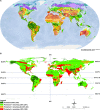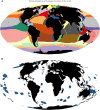A Global Deal For Nature: Guiding principles, milestones, and targets
- PMID: 31016243
- PMCID: PMC6474764
- DOI: 10.1126/sciadv.aaw2869
A Global Deal For Nature: Guiding principles, milestones, and targets
Abstract
The Global Deal for Nature (GDN) is a time-bound, science-driven plan to save the diversity and abundance of life on Earth. Pairing the GDN and the Paris Climate Agreement would avoid catastrophic climate change, conserve species, and secure essential ecosystem services. New findings give urgency to this union: Less than half of the terrestrial realm is intact, yet conserving all native ecosystems-coupled with energy transition measures-will be required to remain below a 1.5°C rise in average global temperature. The GDN targets 30% of Earth to be formally protected and an additional 20% designated as climate stabilization areas, by 2030, to stay below 1.5°C. We highlight the 67% of terrestrial ecoregions that can meet 30% protection, thereby reducing extinction threats and carbon emissions from natural reservoirs. Freshwater and marine targets included here extend the GDN to all realms and provide a pathway to ensuring a more livable biosphere.
Figures



Similar articles
-
A "Global Safety Net" to reverse biodiversity loss and stabilize Earth's climate.Sci Adv. 2020 Sep 4;6(36):eabb2824. doi: 10.1126/sciadv.abb2824. Print 2020 Sep. Sci Adv. 2020. PMID: 32917614 Free PMC article.
-
An Ecoregion-Based Approach to Protecting Half the Terrestrial Realm.Bioscience. 2017 Jun 1;67(6):534-545. doi: 10.1093/biosci/bix014. Epub 2017 Apr 5. Bioscience. 2017. PMID: 28608869 Free PMC article.
-
A climatic stability approach to prioritizing global conservation investments.PLoS One. 2010 Nov 30;5(11):e15103. doi: 10.1371/journal.pone.0015103. PLoS One. 2010. PMID: 21152095 Free PMC article.
-
Climate change and freshwater biodiversity: detected patterns, future trends and adaptations in northern regions.Biol Rev Camb Philos Soc. 2009 Feb;84(1):39-54. doi: 10.1111/j.1469-185X.2008.00060.x. Epub 2008 Nov 11. Biol Rev Camb Philos Soc. 2009. PMID: 19032595 Review.
-
Overcoming the coupled climate and biodiversity crises and their societal impacts.Science. 2023 Apr 21;380(6642):eabl4881. doi: 10.1126/science.abl4881. Epub 2023 Apr 21. Science. 2023. PMID: 37079687 Review.
Cited by
-
Islands are key for protecting the world's plant endemism.Nature. 2024 Oct;634(8035):868-874. doi: 10.1038/s41586-024-08036-1. Epub 2024 Oct 16. Nature. 2024. PMID: 39415003
-
Protection efforts have resulted in ~10% of existing fish biomass on coral reefs.Proc Natl Acad Sci U S A. 2024 Oct 15;121(42):e2308605121. doi: 10.1073/pnas.2308605121. Epub 2024 Oct 7. Proc Natl Acad Sci U S A. 2024. PMID: 39374392 Free PMC article.
-
Climate-Smart Siting for renewable energy expansion.iScience. 2024 Aug 3;27(10):110666. doi: 10.1016/j.isci.2024.110666. eCollection 2024 Oct 18. iScience. 2024. PMID: 39351196 Free PMC article. Review.
-
Mixed effectiveness of global protected areas in resisting habitat loss.Nat Commun. 2024 Sep 27;15(1):8389. doi: 10.1038/s41467-024-52693-9. Nat Commun. 2024. PMID: 39333073 Free PMC article.
-
Mapping global land conversion pressure to support conservation planning.Sci Data. 2024 Jul 30;11(1):830. doi: 10.1038/s41597-024-03639-9. Sci Data. 2024. PMID: 39080308 Free PMC article.
References
-
- Rockström J., Steffen W., Noone K., Persson Å., Chapin F. S. III, Lambin E. F., Lenton T. M., Scheffer M., Folke C., Schellnhuber H. J., Nykvist B., de Wit C. A., Hughes T., van der Leeuw S., Rodhe H., Sörlin S., Snyder P. K., Costanza R., Svedin U., Falkenmark M., Karlberg L., Corell R. W., Fabry V. J., Hansen J., Walker B., Liverman D., Richardson K., Crutzen P., Foley J. A., A safe operating space for humanity. Nature 461, 472–475 (2009). - PubMed
-
- S. Teske, Achieving the Paris Climate Agreement (Springer, 2019).
-
- Tallis H. M., Hawthorne P. L., Polasky S., Reid J., Beck M. W., Brauman K., Bielicki J. M., Binder S., Burgess M. G., Cassidy E., Clark A., Fargione J., Game E. T., Gerber J., Isbell F., Kiesecker J., McDonald R., Metian M., Molnar J. L., Mueller J. L., O’Connell C., Ovando D., Troell M., Boucher T. M., McPeek B., An attainable global vision for conservation and human well-being. Front. Ecol. Environ. 16, 563–570 (2018).
-
- Griscom B. W., Adams J., Ellis P. W., Houghton R. A., Lomax G., Miteva D. A., Schlesinger W. H., Shoch D., Siikamäki J. V., Smith P., Woodbury P., Zganjar C., Blackman A., Campari J., Conant R. T., Delgado C., Elias P., Gopalakrishna T., Hamsik M. R., Herrero M., Kiesecker J., Landis E., Laestadius L., Leavitt S. M., Minnemeyer S., Polasky S., Potapov P., Putz F. E., Sanderman J., Silvius M., Wollenberg E., Fargione J., Natural climate solutions. Proc. Natl. Acad. Sci. U.S.A. 114, 11645–11650 (2017). - PMC - PubMed
-
- Martin T. G., Watson J. E. M., Intact ecosystems provide best defence against climate change. Nat. Clim. Chang. 6, 122–124 (2016).
Publication types
MeSH terms
LinkOut - more resources
Full Text Sources


